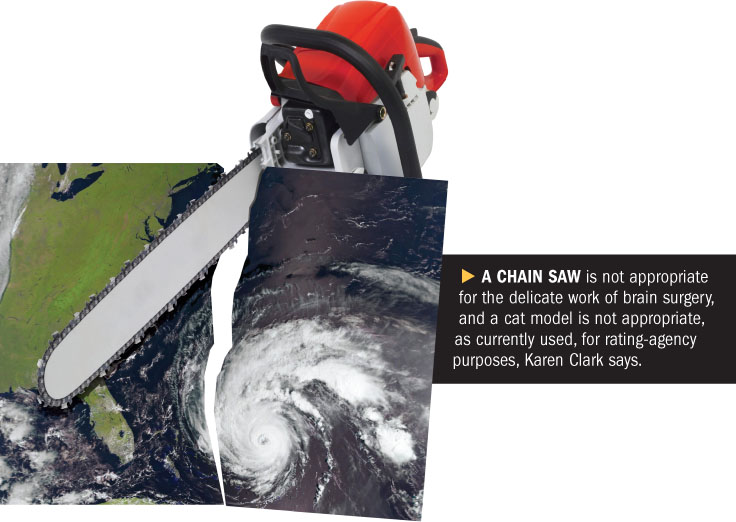The rating agencies are not making consistent comparisons acrosscompanies with respect to catastrophe risk.
|A.M. Best, for example, bases its ratings on information fromdifferent catastrophe models, different model versions and withoutany independent checks on exposure-data quality.
| As is well documented, model- andexposure-data quality differences typically lead to loss estimatesthat vary by 100 to 200 percent or more. While A.M. Best and theother rating agencies claim to make adjustments for thesedifferences, it is simply not possible to know how much the numberswill change when different models or different model versions areused, particularly for localized and specialized portfolios ofproperty business.
As is well documented, model- andexposure-data quality differences typically lead to loss estimatesthat vary by 100 to 200 percent or more. While A.M. Best and theother rating agencies claim to make adjustments for thesedifferences, it is simply not possible to know how much the numberswill change when different models or different model versions areused, particularly for localized and specialized portfolios ofproperty business.
In its March 10 advisory notice A.M. Best is saying, on the onehand, that companies should use the results that they deem mostcredible for their books of business. On the other hand, when thoseresults change, A.M. Best is requiring every company to use the newloss estimates even if the new model may be producing lossestimates that are no longer credible for a company's book ofbusiness. These are conflicting statements.
|The rating-agency practice of making arbitrary adjustments to acompany's loss estimates in an attempt to reflect an update thatmay not be credible for that company is also troublesome.
|An insurance company's rating is a very important indication offinancial health. For non-catastrophe information, rating agencieshave long had the benefit of consistent, independently auditedfinancial information that is derived using well-known and acceptedstandards. Similar standards must be used for catastrophe-lossinformation.
|Cat risk should not be opaque or mysterious for any company. Theprocess by which natural hazards cause damage is straightforward,and so is the modeling process.
|For hurricanes, for example, there is a wind footprint for eachmodeled event, and that footprint is superimposed on the company'sinsured-property values by location. Based on the wind speed andthe type of property, damage functions are applied to estimatedamage to the properties. Policy conditions are thenapplied to the damage to estimate the insured losses from theevent.
|The process is the same for every model. It is the modelfrequency and severity assumptions that differ, resulting indifferences in model outputs.
|So how can the process for gauging cat-risk exposure be mademore transparent and more consistent for rating agencies? The mostimportant step is to develop a consistent, robust set oftransparent scenarios to represent cat risk for each region. Thesame benchmark scenarios can then be applied to every company'sportfolio so the rating agencies are truly comparing apples toapples.
|Let's use the Northeast as an example. Most scientists agreethat the 1938 Great New England Hurricane is the region's worst andmost-damaging event on record. Most sources put the totalinsured wind damage at $20-$30 billion in today's dollars, and thereturn period at 100 years, plus or minus. This is a very plausible100-year benchmark event.
|To appease skeptics who will say this same event is not likelyto happen again, we can anticipate additional scenarios by varyingthe track and other characteristics of the wind footprint todevelop credible 1938-like events.
|There are many advantages to this approach over the currentprocess of using model-generated 100-yearprobable-maximum-loss-point estimates. Among the most important isthat companies and rating agencies can clearly monitor effects ofexposure changes. Currently these cannot be separated from modelchanges and nuances.
|Cat models are blunt tools, not surgical instruments. Over thepast 20 years, the models have improved significantly, advancingone might say from a hand saw to a chain saw. But a saw is still asaw. It is not appropriate for the delicate work of brain surgery,and a cat model is not appropriate, as currently used, forrating-agency purposes.
Want to continue reading?
Become a Free PropertyCasualty360 Digital Reader
Your access to unlimited PropertyCasualty360 content isn’t changing.
Once you are an ALM digital member, you’ll receive:
- All PropertyCasualty360.com news coverage, best practices, and in-depth analysis.
- Educational webcasts, resources from industry leaders, and informative newsletters.
- Other award-winning websites including BenefitsPRO.com and ThinkAdvisor.com.
Already have an account? Sign In
© 2024 ALM Global, LLC, All Rights Reserved. Request academic re-use from www.copyright.com. All other uses, submit a request to [email protected]. For more information visit Asset & Logo Licensing.








